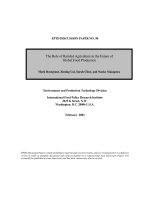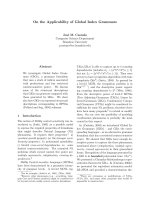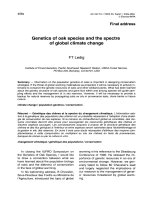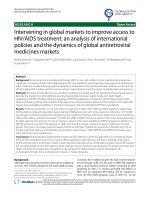The Lure of Global Branding
Bạn đang xem bản rút gọn của tài liệu. Xem và tải ngay bản đầy đủ của tài liệu tại đây (179.34 KB, 22 trang )
The Lure of Global Branding
.
Executive Summary
AS MORE AND MORE COMPANIES
begin to see the
world as their market, brand builders look with envy
upon those businesses that appear to have created
global brands—brands whose positioning, advertising
strategy, personality, look, and feel are in most respects
the same from one country to another. Attracted by such
high-profile examples of success, these companies want
to globalize their own brands.
But that’s a risky path to follow, according to David
Aaker and Erich Joachimsthaler. Why? Because creating
strong global brands takes global brand leadership. It
can’t be done simply by edict from on high. Specifically,
companies must use organizational structures, processes,
and cultures to allocate brand-building resources glob-
ally, to create global synergies, and to develop a global
brand strategy that coordinates and leverages country
brand strategies.
87
HBR033ch5 1/16/02 3:09 PM Page 87
88 Aaker and Joachimsthaler
Aaker and Joachimsthaler offer four prescriptions for
companies seeking to achieve global brand leadership.
First, companies must stimulate the sharing of insights and
best practices across countries—a system in which “it
won’t work here” attitudes can be overcome. Second,
companies should support a common global brand-
planning process, one that is consistent across markets
and products. Third, they should assign global manage-
rial responsibility for brands in order to create cross-coun-
try synergies and to fight local bias. And fourth, they
need to execute brilliant brand-building strategies.
Before stampeding blindly toward global branding,
companies need to think through the systems they have in
place. Otherwise, any success they achieve is likely to
be random—and that’s a fail-safe recipe for mediocrity.
A
come to view the
entire world as their market, brand builders look with
envy upon those that appear to have created global
brands—brands whose positioning, advertising strategy,
personality, look, and feel are in most respects the same
from one country to another. It’s easy to understand
why. Even though most global brands are not absolutely
identical from one country to another—Visa changes its
logo in some countries; Heineken means something dif-
ferent in the Netherlands than it does abroad—compa-
nies whose brands have become more global reap some
clear benefits.
Consider for a moment the economies of scale
enjoyed by IBM. It costs IBM much less to create a single
global advertising campaign than it would to create sep-
HBR033ch5 1/16/02 3:09 PM Page 88
arate campaigns for dozens of markets. And because
IBM uses only one agency for all its global advertising, it
carries a lot of clout with
the agency and can get the
most talented people
working on its behalf. A
global brand also benefits
from being driven by a
single strategy. Visa’s
unvarying “worldwide
acceptance” position, for example, is much easier for the
company to manage than dozens of country-specific
strategies.
Attracted by such high-profile examples of success,
many companies are tempted to try to globalize their
own brands. The problem is, that goal is often unrealis-
tic. Consolidating all advertising into one agency and
developing a global advertising theme—often the corner-
stone of the effort—can cause problems that outweigh
any advantages. And edicts from on high—“Henceforth,
use only brand-building programs that can be applied
across countries”—can prove ineffective or even destruc-
tive. Managers who stampede blindly toward creating a
global brand without considering whether such a move
fits well with their company or their markets risk falling
over a cliff. There are several reasons for that.
First, economies of scale may prove elusive. It is
sometimes cheaper and more effective for companies to
create ads locally than to import ads and then adapt
them for each market. Moreover, cultural differences
may make it hard to pull off a global campaign: even the
best agency may have trouble executing it well in all
countries. Finally, the potential cost savings from “media
Consolidating all
advertising into one agency
and developing a global
theme can cause problems
that outweigh any
advantages.
The Lure of Global Branding 89
HBR033ch5 1/16/02 3:09 PM Page 89
spillover”—in which, for example, people in France view
German television ads—have been exaggerated. Lan-
guage barriers and cultural differences have made realiz-
ing such benefits difficult for most companies.
Second, forming a successful global brand team can
prove difficult. Developing a superior brand strategy for
one country is challenging enough; creating one that
can be applied worldwide can be daunting (assuming
one even exists). Teams face several stumbling blocks:
they need to gather and understand a great deal of
information; they must be extremely creative; and they
need to anticipate a host of challenges in execution.
Relatively few teams will be able to meet all those
challenges.
Third, global brands can’t just be imposed on all mar-
kets. For example, a brand’s image may not be the same
throughout the world. Honda means quality and reliabil-
ity in the United States, but in Japan, where quality is a
given for most cars, Honda represents speed, youth, and
energy. And consider market position. In Britain, where
Ford is number one, the company positioned its Galaxy
minivan as the luxurious “nonvan” in order to appeal not
only to soccer moms but also to executives. But in Ger-
many, where Volkswagen rules, Ford had to position the
Galaxy as “the clever alternative.” Similarly, Cadbury in
the United Kingdom and Milka in Germany have pre-
empted the associations that connect milk with choco-
late; thus neither company could implement a global
positioning strategy.
For all those reasons, taking a more nuanced
approach is the better course of action. Developing
global brands should not be the priority. Instead, compa-
nies should work on creating strong brands in all mar-
kets through global brand leadership.
90 Aaker and Joachimsthaler
HBR033ch5 1/16/02 3:09 PM Page 90
Global brand leadership means using organizational
structures, processes, and cultures to allocate brand-
building resources globally, to create global synergies,
and to develop a global brand strategy that coordinates
and leverages country brand strategies. That is, of
course, easier said than done. For example, companies
tend to give the bulk of their brand-building attention to
countries with large sales—at the expense of emerging
markets that may represent big opportunities. But some
companies have successfully engaged in global brand
management. To find out how, we interviewed execu-
tives from 35 companies in the United States, Europe,
and Japan that have successfully developed strong
brands across countries. (About half the executives were
from companies that made frequently purchased con-
sumer products; the rest represented durables, high-tech
products, and service brands.)
Four common ideas about effective brand leadership
emerged from those interviews. Companies must:
•
stimulate the sharing of insights and best practices
across countries;
•
support a common global brand-planning process;
•
assign managerial responsibility for brands in order
to create cross-country synergies and to fight local
bias; and
•
execute brilliant brand-building strategies.
Sharing Insights and Best Practices
A companywide communication system is the most
basic element of global brand leadership. Managers from
country to country need to be able to find out about
The Lure of Global Branding 91
HBR033ch5 1/16/02 3:09 PM Page 91
programs that have worked or failed elsewhere; they also
need a way to easily give and receive knowledge about
customers—knowledge that will vary from one market to
another.
Creating such a system is harder than it sounds. Busy
people usually have little motivation to take the time to
explain why efforts have been successful or ineffective;
furthermore, they’d rather not give out information that
may leave them exposed to criticism. Another problem is
one that everyone in business faces today: information
overload. And a feeling of “it won’t work here” often per-
vades companies that attempt to encourage the sharing
of market knowledge.
To overcome those problems, companies must nur-
ture and support a culture in which best practices are
freely communicated. In addition, people and proce-
dures must come together to create a rich base of knowl-
edge that is relevant and easy to access. Offering incen-
tives is one way to get people to share what they know.
American Management Systems, for example, keeps
track of the employees who post insights and best prac-
tices and rewards them during annual performance
reviews.
Regular meetings can be an effective way of commu-
nicating insights and best practices. Frito-Lay, for exam-
ple, sponsors a “market university” roughly three times a
year in which 35 or so marketing directors and general
managers from around the world meet in Dallas for a
week. The university gets people to think about brand
leadership concepts, helps people overcome the mind-set
of “I am different—global programs won’t work in my
market,” and creates a group of people around the world
who believe in and understand brands and brand strat-
egy. During the week, country managers present case
92 Aaker and Joachimsthaler
HBR033ch5 1/16/02 3:09 PM Page 92
studies on packaging, advertising, and promotions that
were tested in one country and then successfully applied
in another. The case studies demonstrate that practices
can be transferred even when a local marketing team is
skeptical.
Formal meetings are useful, but true learning takes
place during informal conversations and gatherings.
And the personal relationships that people establish dur-
ing those events are often more important than the
information they share. Personal ties lead to meaningful
exchanges down the road that can foster brand-building
programs.
In addition to staging meetings, companies are
increasingly using intranets to communicate insights
and best practices. (Sharing such information by e-mail
isn’t as effective—there is simply too much e-mail clut-
ter. E-mail is useful, however, for conveying breaking
news about competitors or new technology.) The key is
to have a team create a knowledge bank on an intranet
that is valuable and accessible to those who need it.
Mobil, for example, uses a set of best-practice networks
to do just that. The networks connect people in the com-
pany (and sometimes from partner organizations) who
are experts on, for example, new product introduction,
brand architecture, and retail-site presentation. Each
network has a senior management sponsor and a leader
who actively solicits postings from the experts. The
leader ensures that the information is formatted, orga-
nized, and posted on an easy-to-use intranet site.
Field visits are another useful way to learn about best
practices. Honda sends teams to “live with best prac-
tices” and to learn how they work. In some companies,
the CEO travels to different markets in order to energize
the country teams and to see best practices in action.
The Lure of Global Branding 93
HBR033ch5 1/16/02 3:09 PM Page 93
Procter & Gamble uses worldwide strategic-planning
groups of three to 20 people for each category to encour-
age and support global strategies. The teams have several
tasks. They mine local knowledge about markets and dis-
seminate that information globally. They gather data
about effective country-specific marketing efforts and
encourage testing elsewhere. They create global manu-
facturing sourcing strategies. And they develop policies
that dictate which aspects of the brand strategy must be
followed everywhere and which ones are up to country
management.
Another way that companies can communicate infor-
mation about their brands is by sharing research. Ford
operates very differently from country to country in
Europe, but its businesses share research methods and
findings. Ford UK, for example, which is very skilled at
doing direct mail and research on segmentation, makes
its technology and research methods available to other
countries. That’s especially important for businesses in
small markets that are short on budget and staff.
Supporting Global Brand Planning
Two years ago, the newly appointed global brand man-
ager of a prominent packaged-goods marketer orga-
nized a brand strategy review. He found that all the
country brand managers used their own vocabularies
and strategy templates and had their own strategies.
The resulting mess had undoubtedly contributed to
inferior marketing and weakened brands. Another
packaged-goods company tried to avoid that problem
by developing a global planning system. Brand man-
agers weren’t given incentives or trained properly to use
the system, however, and the result was inconsistent,
half-hearted efforts at planning.
94 Aaker and Joachimsthaler
HBR033ch5 1/16/02 3:09 PM Page 94









